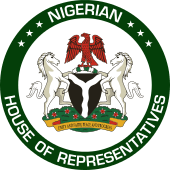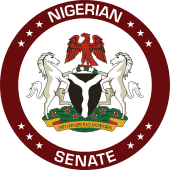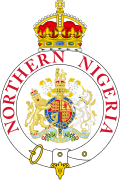Coat of arms of Nigeria
| Coat of arms of Nigeria | |
|---|---|
 | |
| Versions | |
|
Version used from 1960 to 1979 | |
| Details | |
| Armiger | Federal Republic of Nigeria |
| Adopted | 20 May 1960 |
| Crest | An eagle displayed Gules. |
| Torse | Argent and Vert |
| Escutcheon | Sable a Pall wavy argent |
| Supporters | Two horses Argent |
| Compartment | A grassy field proper, the yellow flowers at the base (incorrectly shown as red in the image) are Costus Spectabilis, Nigeria's national flower. |
| Motto | Unity and Faith, Peace and Progress |
The coat of arms of Nigeria has a black shield with two white lines that form in a "Y" shape. The black shield represents Nigeria's fertile soil, while the two horses or chargers on each side represent dignity. The eagle represents strength, while the green and white bands on the top of the shield represent the rich soil.[1]
The red flowers at the base are Costus spectabilis, Nigeria's national flower. This flower was chosen for inclusion in the coat of arms as it is found all over Nigeria and also stand for the beauty of the nation. The white wavy pall represents the Niger and the Benue. On the banderole around the base is Nigeria's national motto since 1978: "Unity and Faith, Peace and Progress" (formerly "Peace, Unity, Freedom").[1]
Blazon
Sable a Pall wavy argent, supported by two horses Argent, and set for a crest on a wreath, Argent and Vert, an eagle displayed Gules.
Gallery
-

Seal of the President
-

Seal of the Vice President
-

Seal of the House of Representatives
-

Seal of the Senate
Historical emblems
-
.svg.png)
Badge of the British West African Settlements
-
.svg.png)
Badge of the Lagos Colony
-

Badge of the Oil Rivers Protectorate
-

Badge of the Niger Coast Protectorate
-

Badge of the Northern Nigeria Protectorate
-

Badge of the Southern Nigeria Protectorate
See also
References
- 1 2 "National Symbols - Emblem". Nigeria's 50th Independence: Celebrating Greatness. Retrieved May 21, 2012.
.svg.png)